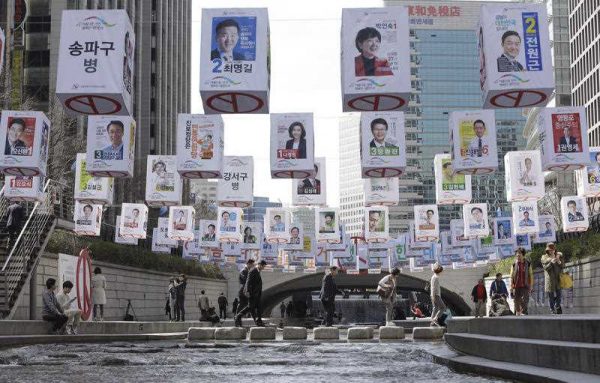Part of the malaise stems from the fact that South Korean presidents are restricted to a single five-year term in office. When South Korea democratised in 1987, this deliberate safeguard was written into the new constitution as a check against backsliding towards military dictatorship. Since then, South Korea has consolidated its democracy. It has held seven elections for the National Assembly as well as six presidential elections, and there have been changes of government from ruling to opposition parties. Almost 30 years on, the legitimacy of elections, respected by both winners and losers in the process, has become entrenched.
But the ROK constitutional set up has unintended consequences. South Korean presidents are forced to focus on legacy issues from day one of their election. Rather than having time to build consensus and listen to the views of both the opposition and a cross-section of the community they are elected to represent, the race to pass legislation, institute new programs and leave their mark on history has become more a sprint, than a marathon for the long distance.
The lead up to this election has illustrated how the one-term presidential system has exacerbated the cold relationship between the Blue House (the executive office and official residence of the president) and the Saenuri in the National Assembly. As Park has stumbled from one crisis to another — the Sewol Ferry sinking, the MERS flu outbreak and the history textbook controversy — her domestic popularity has taken a beating. And since Park cannot run for re-election the Saenuri has little incentive to cooperate with her, despite the fact that they hail from the same party.
Park’s battles with National Assembly floor leader Yoo Seung-min illustrate the problem. Yoo was a former aide and confidant of Park, but the two fell out after Park failed to win the party nomination for the 2007 presidential election. Yoo was elected as Saenuri’s floor leader in February 2015 and vowed to revitalise relations between the party and the Blue House, promising increased communication and cooperation. But after Yoo negotiated a compromise with the opposition on a revision to the National Assembly Act, Park publicly attacked him, vetoing the revision. Park labelled Yoo’s version of the bill unconstitutional and accused him of engaging in the ‘politics of betrayal’. Yoo was ultimately forced to resign over the matter in July 2015.
The battle between the Blue House and the party has intensified in the lead up to the election over the candidate nomination process, as Park sought to take back control of the party in the legislature. The nomination committee is chaired by Park loyalist Lee Han-koo and Park loyalists have been given the nod for nominations at the expense of her adversaries. Some Saenuri incumbents, including Yoo, were even forced out of the party to run as independents.
The anti-Park faction has struck back. Saenuri Party Chief Kim Moo-sung, who is widely believed to be eyeing a run at the presidency next year, has emerged as Park’s nemesis and vetoed the nomination committee’s selection of five Park loyalists as candidates. Because the deadline to leave the party to run as independents had already then passed, Kim’s move effectively blocked candidates from running in the election at all and left Saenuri with no candidates contesting those five seats. At the same time, Saenuri shifted its election strategy to distance itself from Park and removed any reminders of the President from their campaign materials.
The silver lining for Saenuri is that the opposition has failed to capitalise on its squabbling. The largest opposition party, the progressive Minjoo (‘Together Democratic’) Party, has itself been torn by internal strife, with Ahn Cheol-soo splintering off and forming his own Kookmin (People’s) Party in February 2016 after a protracted leadership struggle. Given South Korea’s first-past-the-post voting system, a splintered opposition vote hands Saenuri a decisive advantage.
The big questions going forward are: can the Saenuri reach the 180 seat threshold that would allow it to put bills to a vote unilaterally without consulting minority parties? And, once the dust settles, will Park really be able to take back control of the party in the assembly? The answers to these questions are unclear. But the real loser in these elections appear to be the South Korean people who look like they must endure (at least until the next president takes office in February 2018) continuing political gridlock.
Ben Ascione is a PhD candidate at the Crawford School of Public Policy, The Australian National University. He is Japan and Korea editor at East Asia Forum and a research associate of the Japan Center for International Exchange in Tokyo.

